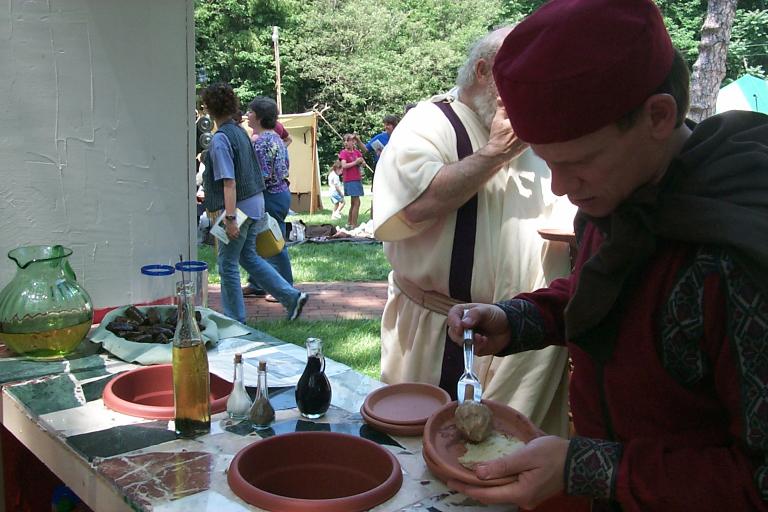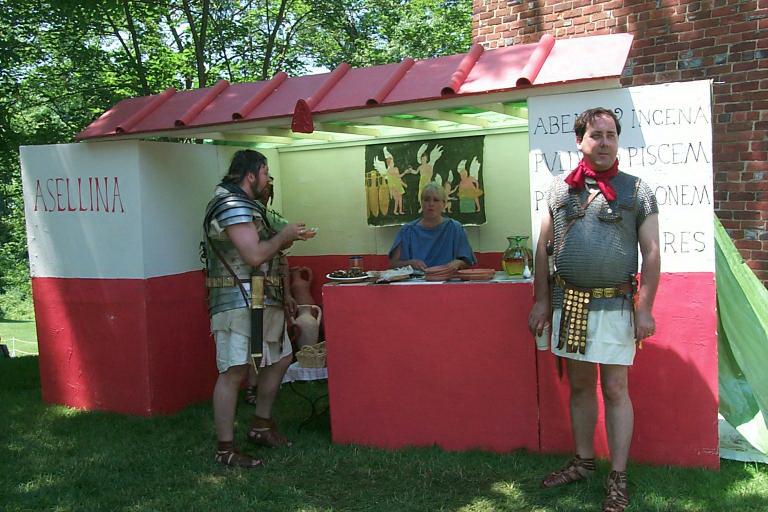I've had several requests for more detail on the construction of the flats, how they are joined, how the roof works, and the types of paints used. Art Gamon, in California, is reproducing the caupona but a bit differently, with folding roof parts to save on transport problems. He's promised photos.....
After several moves, the pure styrofoam of the roof parts, small as they are, broke up and the paint flaked off. I have sandwiched the styrofoam in luan, and then painted that with texture paint. This is a lot heavier, but a benefit is that the panels need only be laid down on the roof, with nails to keep them from sliding off. Big improvement in time of setup.
We have not done the stall yet, but even that has progressed in design. Rather than try vertical bars to keep the panels apart, I've decided on just thin styrofoam; this allows the panels to be packed in a bit better with less movement.
To expand the caupona and make another shop, I have enough spare parts to make six more panels, and I am working on a Cave Canem mosaic, courtesy of Forum Trajani and Mosaic Makers. . I am also working on the production of amphora using forms and slab rolled clay.
Asellina has been working on hand spinning using a drop spindle and wool. She's also been trying various garum recipes, which some people actually like!
May 2002
After moving the caupona panel by panel, we decided to employ another theatrical technique, the 'stall'. In the theatre, you store flats upright in stalls, which are bins that hold the flats upright and apart. We are designing a mobile stall, one that stores each flat separately and securely, but is on rollers and has the ability to be tipped into a van in one unit, taken to an event, unloaded, wheeled to the site, unloaded and set up, then done in reverse when 'breaking set'. This will also keep all the parts and spares in one place, on the stall itself.
July 9, 2001: What next?
At the Legio XX fabricum July 7, we discussed the next steps. Feedback from those who have seen the photos has all been enthusiastic, and the appearance has been described as 'real', though maybe a bit overdone there.
The success of the caupona has inspired a new shop! A laundry is being discussed, to be attached to the caupona, and there was talk of an oven for baking bread and possibly a hand grain grinder. This would mean a bit larger caupona, and an extension of the dolia/counter into an L shape, as most were anyway in Pompeii and Heculaneum.
As this is basically a traveling theatrical set, these will not
be difficult technically to add. I still think the roof tiles should be individual:
this will be a challenge to recreate and mount, requiring a new thinking on
the roof. 
A detail of the marble counter with 4th century AD Roman soldier.
We finished! The caupona debuted at Roman Days and was very well
received. Allison, now forever Asellina, said the visitors were very enthusiastic,
and they were pleased that the depiction of the civilian side of Rome was
being expanded. The Marietta Mansion organisers felt it added a new dimension
to the overall event.

Logistically, renting a full size GMC van was cumbersome, particularly when
Budget shut down in front of us forcing us to return the Saturday of the
event! Needless to say we were late.
The caupona fit within the van with room to spare, including the food containers,
trays, washing equipment, amphorae, and other things I'd not originally planned
for. I wish I had tried it with a mini-van, but that will have to wait for
another event.
The caupona went up well on uneven, sloping ground. The only problem was the styrofoam roof, where the alignment screws no longer matched up. Fortunately, styfrofoam warps, and is easy to punch new holes in. Unfortunately, that adds to the maintenance later on.
at this point. Paint at the discount
warehouse hardware stores is
impossible to match: I suggest
using a professional paint store.
A precision mitre saw was a real productivity enhancer.
Almost finished! Thanks to Roger Moskey for the roof line, Matt
Amt for design, and Pete Keefer for rafter construction. It all fits together
very well, and is straight and pretty rigid. We did decide on hinges to hold
the panels together, removing the pins for disassembly. The 'tile'
is being done in styrofoam, simulating the imbrex size of 60cm x 45cm. We
are making antefix of the 20th, thanks to the Chester Museum.
The counter is done except for paint, with the marble top finished. We do
not have terracotta dolia (the pans inserted into the counter top) so are
substituting until we can find some.
The entire structure can be assembled in 10 minutes, disassembled in the
same. This is a great help.
We are already planning additional panels, and probably an addition of a
bronze shop next.
PROPS: we have ordered Samian Ware from the UK, and are hoping for some Roman
glass. Both may nor arrive by June 9, but fingers are crossed.
10 sq ft marble: free
8'x4' styrofoam: $10
4" wide PVC pipe
more hinges, removable
pins
Still looking for: Amphora
April 15
The panels are finished, though rain and sub-50' weather has delayed painting. We finally took all the panels outside for the first time and stood them up. As I began painting the red, as luck would have it rain clouds appeared, so I hastily took Asellina outside to get a first photo. The panels are not lashed together, they need stiffening braces, and one panel needs redoing: somehow the paint turned color. But it is an idea of how it will look. We have the marble for the counter top, and all the wood for the counter. We are looking for someone to do authentic Roman roof tiles, and to fabricate a 20th legion antefix for the roof tile ends. And a few other things.
Here's Asellina in front of the hastily assembled caupona.
- two gallons sand paint: $12
- ten sq. ft. marble, ass't broken: free
- 1 gal red paint: $15
- hinges: $12
Having completed four 1/4 size, luaun covered panels, these were shown at Lupercalia and were well received.
The four linked images show:
- The four panels, with Latin menu
- The junction of the panels
- A corner block
- An idea of the surface texture
We now need to find hinges for 90' and 270', and a means to fasten the panels to the ground. Tracy Cope suggested a pin to align the sides, and Merlinia (Joanne Shaver) suggested small blocks to keep the wood off damp ground, plus using iron rods, running through loops, to go into the ground as anchors.
Merlinia has ideas for the furniture in the caupona, and will be working on a table and chairs based on those in a recent exhibit at the Museum of London. I have written to a person in the UK who makes the red Samian ware for use in the exhibit.
"Those staples look cheesy."
The general consensus was that the standard theatrical flat, with staples on the face of the flat, would not stand close scrutiny from the public since they aren't out 40 feet away sitting in chairs. So, the vote is for luan paneling. Also, the "Sculpt and Coat" results were disappointing, as it did not convey the texture of plaster we'd hoped for. Not to mention the expense.
We have the luan in hand, and will build another flat for the Legio XX Lupercalia party. This will use a sand texture paint. We will redo the other flat so that we can demonstrate hinges and lashing techniques.
We also borrowed two books from Matthew Amt on pottery and household artifacts:
- "The Finds of Roman Britain" Guy de la Bedoyere, Batsford, 1989.
- "Pottery in Roman Britain" Vivien Swan, Shire Archaeology, 1988 (4th edition)
- "Roman Clothing and Fashion" A. T. Croom, Tempus, 2000
- "Costume of Ancient Rome" David Symons, Chelsea House, 1987
I've constructed the frames of the first flats. This follows theatrical conventions as described in
- "Scene Design and Stage Lighting" by W. Oren Parker, Seventh Edition.
- "The Stage and the School" by Katherine Anne Ommanney, Fifth Edition
Any questions please email me at Richsc@usa.net
- Richard Campbell
- Allison Campbell
We welcome Merlinia to the team!
We cut 1/4" plywood for cornerblocks, cut to 6"x6" square, and screwed down rather than nailed. These corner blocks are offset from the edge of the rail by the thickness of the 1"x3", to allow for hinging the joints.
Materials so far:
- 1"x3" pine for frame
- 1/4" plywood cut to 6" squares (a 2'x4' square yields 32 six inch cornerblocks)
- #10 3/4 " screws
- Counter sink drill bit with collar (to maintain consistent depth)
- handy reversible variable speed drill with screw bits
- Large carpenter's square
- Circular Saw with fine blade (not ripping)
1x3 by six foot: $1.80 each
2'x4' 1/4" plywood: $2.40
about 20 screws
Other Materials:
Canvas Duck
Unbleached heavy Muslin: $6/yd x 120"
Argo sizing: $1.50/pound
Sculpt or Coat: $16.90/Qt